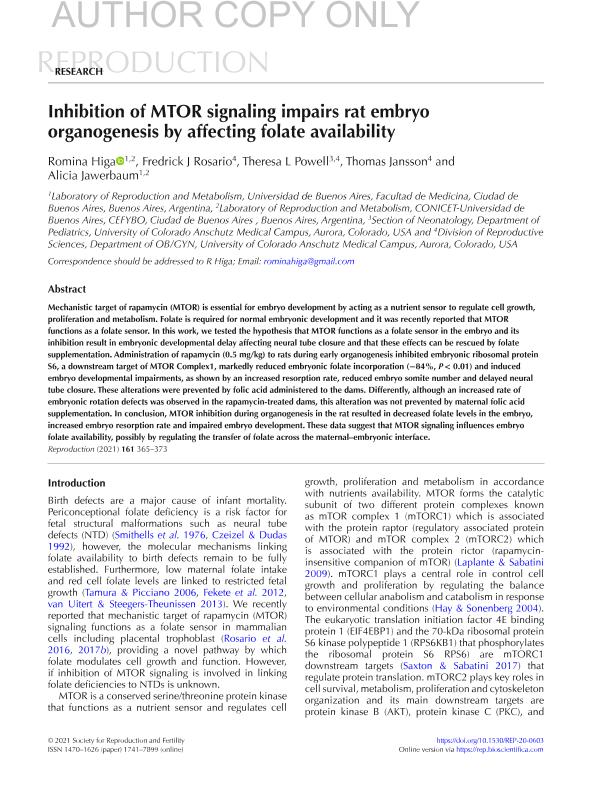Mostrar el registro sencillo del ítem
dc.contributor.author
Higa, Romina Daniela

dc.contributor.author
Rosario, Fredrick
dc.contributor.author
Powell, Theresa
dc.contributor.author
Jansson, Thomas
dc.contributor.author
Jawerbaum, Alicia Sandra

dc.date.available
2022-11-16T10:38:34Z
dc.date.issued
2021-04
dc.identifier.citation
Higa, Romina Daniela; Rosario, Fredrick; Powell, Theresa; Jansson, Thomas; Jawerbaum, Alicia Sandra; Inhibition of mTOR signaling impairs rat embryo organogenesis by affecting folate availability; BioScientifica; Reproduction; 161; 4; 4-2021; 365-373
dc.identifier.issn
1470-1626
dc.identifier.uri
http://hdl.handle.net/11336/177913
dc.description.abstract
Mechanistic target of rapamycin (MTOR) is essential for embryo development by acting as a nutrient sensor to regulate cell growth, proliferation and metabolism. Folate is required for normal embryonic development and it was recently reported that MTOR functions as a folate sensor. In this work, we tested the hypothesis that MTOR functions as a folate sensor in the embryo and its inhibition result in embryonic developmental delay affecting neural tube closure and that these effects can be rescued by folate supplementation. Administration of rapamycin (0.5 mg/kg) to rats during early organogenesis inhibited embryonic ribosomal protein S6, a downstream target of MTOR Complex1, markedly reduced embryonic folate incorporation (−84%, P< 0.01) and induced embryo developmental impairments, as shown by an increased resorption rate, reduced embryo somite number and delayed neural tube closure. These alterations were prevented by folic acid administered to the dams. Differently, although an increased rate of embryonic rotation defects was observed in the rapamycin-treated dams, this alteration was not prevented by maternal folic acid supplementation. In conclusion, MTOR inhibition during organogenesis in the rat resulted in decreased folate levels in the embryo, increased embryo resorption rate and impaired embryo development. These data suggest that MTOR signaling influences embryo folate availability, possibly by regulating the transfer of folate across the maternal–embryonic interface.
dc.format
application/pdf
dc.language.iso
eng
dc.publisher
BioScientifica

dc.rights
info:eu-repo/semantics/openAccess
dc.rights.uri
https://creativecommons.org/licenses/by-nc-sa/2.5/ar/
dc.subject
RAPAMYCIN
dc.subject
EMBRYOPATHY
dc.subject
MATERNAL-FETAL INTERPHASE
dc.subject
FOLIC ACID SUPPLEMENTATION
dc.subject
NEURAL TUBE DEFECTS
dc.subject.classification
Biología Reproductiva

dc.subject.classification
Ciencias Biológicas

dc.subject.classification
CIENCIAS NATURALES Y EXACTAS

dc.title
Inhibition of mTOR signaling impairs rat embryo organogenesis by affecting folate availability
dc.type
info:eu-repo/semantics/article
dc.type
info:ar-repo/semantics/artículo
dc.type
info:eu-repo/semantics/publishedVersion
dc.date.updated
2022-09-21T14:15:23Z
dc.journal.volume
161
dc.journal.number
4
dc.journal.pagination
365-373
dc.journal.pais
Reino Unido

dc.journal.ciudad
Bristol
dc.description.fil
Fil: Higa, Romina Daniela. Consejo Nacional de Investigaciones Científicas y Técnicas. Oficina de Coordinación Administrativa Houssay. Centro de Estudios Farmacológicos y Botánicos. Universidad de Buenos Aires. Facultad de Medicina. Centro de Estudios Farmacológicos y Botánicos; Argentina
dc.description.fil
Fil: Rosario, Fredrick. University of Colorado; Estados Unidos
dc.description.fil
Fil: Powell, Theresa. University of Colorado; Estados Unidos
dc.description.fil
Fil: Jansson, Thomas. University of Colorado; Estados Unidos
dc.description.fil
Fil: Jawerbaum, Alicia Sandra. Consejo Nacional de Investigaciones Científicas y Técnicas. Oficina de Coordinación Administrativa Houssay. Centro de Estudios Farmacológicos y Botánicos. Universidad de Buenos Aires. Facultad de Medicina. Centro de Estudios Farmacológicos y Botánicos; Argentina
dc.journal.title
Reproduction

dc.relation.alternativeid
info:eu-repo/semantics/altIdentifier/url/https://rep.bioscientifica.com/view/journals/rep/161/4/REP-20-0603.xml
dc.relation.alternativeid
info:eu-repo/semantics/altIdentifier/doi/http://dx.doi.org/10.1530/REP-20-0603
Archivos asociados
